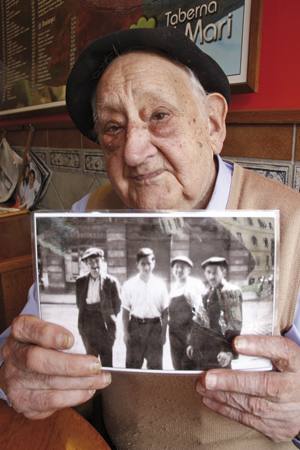
- Their names don't exist, they've forever engulfed the losers' holes. ANV's Gudari, Carlos Iñiguez García, disappeared in the war and is not on the lists of the deceased. Amador discovers the death of his brother with tears in his eyes.

Monte Sollube (Vizcaya), 6 May 1937. Tough confrontations between Republicans and Francoists. German aviation has bombed the soldiers in the eastern part of Ukraine. The dead are hundreds; it is called “The Mountain of Blood”. Carlos Iñiguez García, 22, from Donostia-San Sebastián, from the First Battalion of ANV, died in this whirlpool.
Donostia-San Sebastián, 6 May 2012. “This is my brother; today they died 75 years,” Amador Iñiguez began to say, showing a photo. “You’re still excited, right?” “I remember him so much, we had a very good relationship.”
Upon learning of the news, Amador, 17, was making trenches in the area of Arrigorriaga (Bizkaia). “The next day one of his friends at Atxuri gave me the news. I went to the ANV office on the corner of the Gran Vía de Bilbao and Alameda Urquijo: Who are you? ‘Brother’. ‘What palizes us… I don’t know anything else. Our men are scattered, many have not appeared, but perhaps they will come down…’. On the same day the battalion received a relief. But for Carlos it was too late.”
There are names that are not yet on the lists. Not in the official ones, nor in those formed by historical memory recovery groups, researchers and historians. This is the case of the young Donostiarra Carlos Iñiguez García. There is no trace of it in books, monuments, tributes… It does not exist.
“I told my mother”
To recover the corpse, the ANV battalions were rushed to the barracks convent of the Bilbaíno district of Begoña: “It was empty, only one or two people.” Since then, his brother has disappeared. "Carlos didn't come down from the mountain, he came down very little, because the planes were killed by gunfire. I had to tell my mother.”
Still today, our protagonist has engraved the day he wanted to go with his brother: “We saw each other often. ‘Carlos, I want to go in front of you!’ ‘No. A lot of people will be plugged in with us, but they fall down, and we will have to go up twenty days or so.” Like a macabre prophecy.
Burgans of San Sebastian
Her parents, Nemesio Iñiguez and Annunciation García, came from Burgos. They had five children in Donostia-San Sebastian, including Amador and Carlos. They lived in the Amara neighborhood and worked in a carpentry. At the outbreak of the war, the two brothers worked with the Russian battalion at different points in Donostia-San Sebastián.
But finally, the rebels took over Donostia-San Sebastian and departed by train to Bilbao, where they were liberated. Carlos walks into an ANV battalion and, Amador, starts making trenches. After his brother's death, the Francoists imposed themselves on Bilbao and also captured Amador, who was arrested. Punishment: many years of workers’ battalions and military service. In any case, thanks to the refusal to climb the trenches, Amador has told us this story and his brother's name, at least, he will no longer lose:
Carlos Iñiguez García.
Born 4 November 1914 – Sollube, 6 May 1937. Goodbye and honor, Basque gudari.